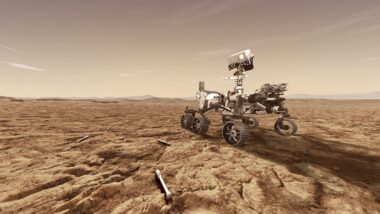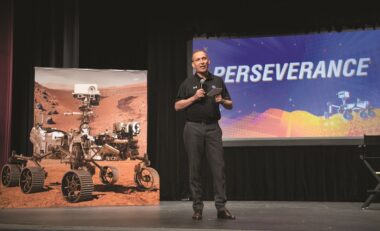The next day, Tianwen-1, China’s first dedicated Mars mission, arrived, entering orbit to identify a target for its lander and rover, which will attempt a landing in May.
On Feb. 18, it’s NASA’s turn. The Mars 2020 spacecraft arrives at Mars, due to land at Jezero Crater. The landing will feature the same “seven minutes of terror” as the Curiosity rover experienced in 2012, and Mars 2020’s Perseverance rover looks much like its predecessor. Its mission, though, is quite different and, in many respects, won’t end for at least a decade, when the samples it collects arrive back on Earth.
The logical next step in Mars exploration
When NASA announced in late 2012 it would fly Mars 2020, it based its decision on the planetary science decadal survey in 2011. That study ranked as its highest priority flagship-class mission a concept called Mars Astrobiology Explorer Cacher (MAX-C), a rover that would study the planet’s habitability and also collect, or cache, samples for return to Earth by later missions.
“The Mars community, in their inputs to the decadal survey, was emphatic in their view that a sample return mission is the logical next step in Mars exploration,” the survey’s final report noted.
The study acknowledged that MAX-C would be just the first step in getting those samples back to Earth. NASA would need to fly later missions to collect and return the cached samples, but those were beyond the scope of the decadal survey, which was limited to missions expected to launch between 2013 and 2022.

NASA got serious about planning for those future missions in 2017, when it announced what it called a “lean” sample return architecture. It was not that different, though, from earlier concepts, calling for two additional missions. One would land near Mars 2020 and deploy a “fetch rover” to collect the samples cached by the earlier mission. That rover would return the samples to the lander, load them into a small rocket called a Mars Ascent Vehicle (MAV) and launch them into orbit. A second mission, an orbiter, would collect the sample container launched by the MAV and return it to Earth.
By the time Mars 2020 launched in July, NASA had refined that architecture and also brought on board the European Space Agency, which would lead development of the orbiter mission and provide the fetch rover for the NASA-led lander. Airbus Defence and Space received an ESA contract in October for the orbiter, valued at 491 million euros ($595 million.)
When Mars 2020 launched, NASA planned to move the Mars Sample Return program into Phase A of development around September. But in August, the agency announced it would first conduct an independent review of the program. Thomas Zurbuchen, NASA associate administrator for science, requested the review based on the experience with the Nancy Grace Roman Space Telescope (formerly WFIRST), which had a similar review in 2017 that identified cost and technical issues with the mission.
“The primary objectives are to make sure we’re on a good footing going forward and that we have the resources we need to execute the mission and be successful,” said Jeff Gramling, Mars Sample Return program director at NASA Headquarters, when NASA announced the study.
Proceed with caution
The independent review board (IRB) was led by David Thompson, the retired president and chief executive of Orbital ATK, with a team of engineers and scientists from both inside and outside NASA. They worked for two months on the study, which was released, along with the agency’s response, Nov. 10.
The good news for NASA was that the independent study vigorously backed Mars Sample Return. “We unanimously believe that the Mars Sample Return program should proceed,” Thompson said in a call with reporters about the study. “We think its scientific value would be extraordinarily high.”
“Full steam ahead,” added Maria Zuber, a planetary scientist at the Massachusetts Institute of Technology who served on the independent review and also chairs a separate standing review board for the program.
The study, though, took issue with some of NASA’s plans for Mars Sample Return, including its schedule. The architecture NASA presented to the independent review was one sometimes called “26-26-31” by the agency: both the lander and orbiter would launch in 2026, with the samples returned in 2031.
That schedule was too aggressive for the independent panel. “The schedules required to support launches in 2026 were substantially shorter than the actual experience from recent, somewhat similar programs,” like Mars 2020 and Curiosity, Thompson said.
Under a revised schedule recommended by the panel, the lander mission would launch in 2028. The orbiter could launch in either 2027 or 2028, since its use of electric propulsion gives it the flexibility to pursue alternative trajectories. That revised schedule would delay the return of the samples until 2033.
At the same time, the study warned about delaying the missions beyond 2028. “The conditions when you arrive at Mars change dramatically over the Martian year,” explained Peter Theisinger of the Jet Propulsion Laboratory, a member of the IRB who previously managed the Curiosity mission.
“Launch opportunities after 2028 don’t arrive at a very attractive season,” he added, with the potential for dust storms like the one in 2018 that led to the demise of the solar-powered Opportunity rover, and other changes in the atmosphere that would complicate the landing. “A significant redesign for the early ’30s would be required, and we want to avoid doing that in the middle of the program.”
The independent panel, though, wasn’t shy about suggesting changes to the mission in this early design phase. Thompson put a particular emphasis on studies examining whether the lander mission should be split into two: one carrying the fetch rover and the other the MAV. It also recommended looking at adding a radioisotope thermoelectric generator (RTG) to the lander, or at least the lander with the MAV, to ensure sufficient power and to keep the rocket’s propulsion system from getting too cold.

There’s also the issue of cost. NASA had been reticent to discuss the cost of Mars Sample Return since it was still far from the point where NASA makes a formal cost commitment. Zurbuchen, speaking at a Mars 2020 prelaunch briefing, estimated NASA’s cost of the later phases of the program would be $2.5 billion to $3 billion, a figure that didn’t include the $2.4 billion spent on Mars 2020 or ESA’s estimated contribution of 1.5 billion euros.
Thompson said that NASA’s cost estimates at the time of the independent review were $2.9 billion to $3.3 billion at a confidence level of 50%. That was too low, especially if the launches were delayed to 2028. “We concluded the total budget, to get into the range of a 70-80% confidence level, should be increased by about a billion dollars,” he said, or to about $3.8 billion to $4.4 billion.
Balancing the portfolio
NASA welcomed the independent review board’s report but stopped short of endorsing some of its biggest recommendations, particularly on cost and schedule. “It requires bringing with us a community,” said Zurbuchen, including ESA as well as Congress, which will have to agree to any delays and additional costs. He suggested “a time scale of a year or so” before NASA makes any decision on delaying the missions or increasing the program’s budget.
That decision will be informed by studies done under Phase A of the program, which formally started Dec. 17. That will further refine the design of the missions and address some of the issues raised by the independent review.
The planetary science community, meanwhile, is nervously watching the status of Mars Sample Return and the effect it could have on other parts of the field. Increased costs could take money away from other planetary programs, as well as make it unlikely other Mars missions would fly this decade.
Lori Glaze, director of NASA’s planetary science division, addressed that at a town hall meeting during the American Geophysical Union’s Fall Meeting in December. “I certainly do recognize and understand that it’s critically important that we maintain the balance within the portfolio and that we continue to have funding to support the other missions throughout the solar system,” she said.
That balance will also be affected by the recommendations of the next planetary science decadal survey, currently underway and scheduled for release in March 2022. The decadal won’t attempt to prioritize Mars Sample Return against other missions, said David Smith, study director for the decadal at the National Academies, but “we are encouraged to comment on NASA’s current plans to implement the second and third phases of a Mars sample return campaign.”
The previous decadal survey anticipated that when it endorsed the MAX-C mission. “The committee has therefore taken the unusual step of recommending a plan for the coming decade that also has significant budget implications for one or even two decades beyond,” the report stated. “The committee does this intentionally and explicitly, with the realization that important multi-decade efforts like Mars Sample Return can come about only if such recommendations are made and followed.”
Making such recommendations is easy enough. Following them, as Mars Sample Return shows, can be much more challenging.
A version of this article originally appeared in the Jan. 18, 2021 issue of SpaceNews magazine.



